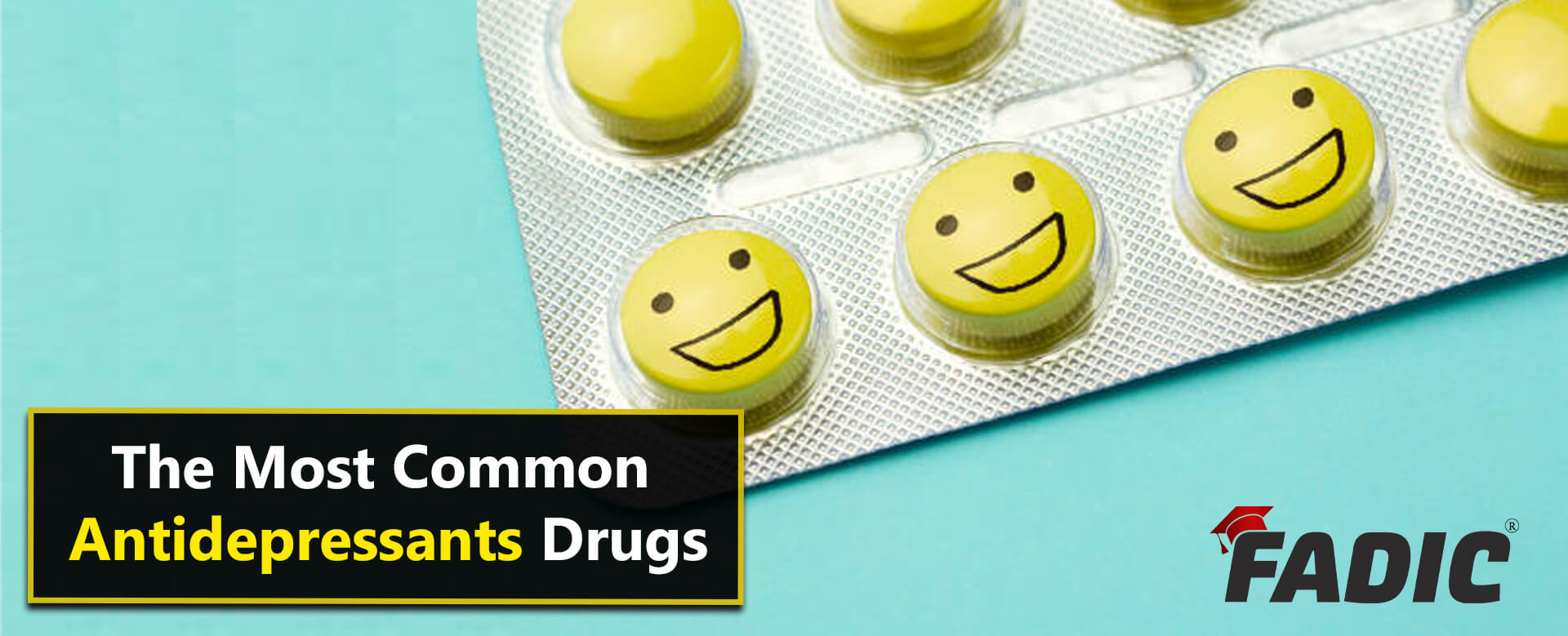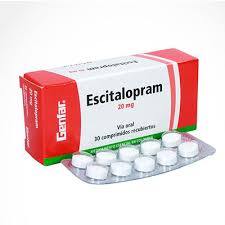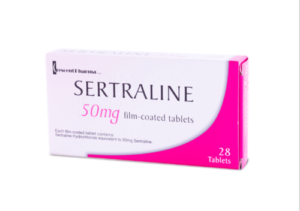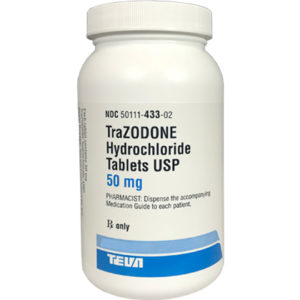10 Antidepressants Commonly Used: doses, side effects, and uses
The Most Famous 10 Antidepressants Commonly Used: doses, side effects, and uses:
1- Citalopram 💊
2-Escitalopram 💊
3-FLUoxetine 💊
4-Sertraline 💊
5-TraZODone 💊
6-BuPROPion💊
7-DULoxetine 💊
8-Mirtazapine💊
9-Paroxetine 💊
10-Venlafaxine 💊
Citalopram
- Brand Names: CeleXA
- Therapeutic Category: Antidepressants, Selective Serotonin Reuptake Inhibitors
- Dosage Forms: Oral / Tablet, Solution
- Use: Labeled Indications:
- Treatment of the unipolar major depressive disorder
- Off Label: Aggressive or agitated behaviour associated with dementia/ Binge eating disorder/ Generalized anxiety disorder/ Obsessive-compulsive disorder/ Panic disorder/ Posttraumatic stress disorder
- Dosing: Adult : Oral: Initial: 10 mg once daily; increase to 20 mg once daily after ≥3 days. In adults ≤60 years, may further increase the dose based on response and tolerability up to 30 mg/day, for adults >60 years, do not exceed the maximum amount of 20 mg/day.
- Pediatric: Children 7 to ≤11 years: Initial: 5 to 10 mg/day given once daily; increase the dose slowly by 5 mg/day every two weeks as clinically needed; dosage range: 10 to 40 mg/day
- Children and Adolescents ≥12 years: Initial: 10 to 20 mg/day given once daily; increase the dose slowly by 10 mg/day every two weeks as clinically needed; dosage range: 10 to 40 mg/day
- Dose Adjustments
- Renal Impairment: no dosage adjustments
- Hepatic Impairment: Maximum recommended dose: 20 mg daily due to decreased clearance and the risk of QT prolongation
- Adverse Drug Interaction:
Drowsiness, insomnia, Diaphoresis, Nausea, xerostomia - Pharmacodynamics/Kinetics:
- Onset of action: Depression: The onset of action is 1 to 4 weeks
- Duration: 1 to 2 days
- Half-life elimination: 24 to 48 hours
- Important Notes:
- Antidepressants increased the risk of suicidal thinking and behaviour (suicidality) compared with placebo in short-term studies in children, adolescents, and young adults with major depressive disorder and other psychiatric disorders.
- Pregnancy & Lactation: Pregnancy Risk factor C / present in breast milk
- Medication Safety Issues:CeleXA may be confused with CeleBREX, Cerebyx, Ranexa, and ZyPREXA.
Highly Recommend this Hydrossential Serum: Amazing for your Skin
Escitalopram
- Brand Names: Lexapro
- Therapeutic Category: Antidepressants, Selective Serotonin Reuptake Inhibitors
- Dosage Forms: Oral / Tablet, Solution
- Use: Labeled Indications:
- Major depressive disorder (unipolar)/ Generalized anxiety disorder
- Off Label: Binge eating disorder/ Body dysmorphic disorder/ Bulimia nervosa/ Obsessive-compulsive disorder (OCD)/ Panic disorder
- Dosing: Adult : Oral: Initial: 10 mg once daily; dose may be increased in 10 mg increments at intervals ≥1 week up to 40 mg once daily
- Pediatric: Children <12 years: Limited data available; only one randomized, placebo-controlled trial has been published; efficacy was not demonstrated for children <12 years of age
- Children and Adolescents ≥12 years: Initial: 10 mg once daily; may be increased to 20 mg/day after at least three weeks
- Dose Adjustments
- Renal Impairment: Severe impairment: CrCl <20 mL/minute: Use with caution.
- Hepatic Impairment: 10 mg once daily
- Adverse Drug Interaction:
Headache, insomnia, drowsiness, Nausea, diarrhoea, Ejaculatory disorder - Pharmacodynamics/Kinetics:
- Onset of action: Depression: The onset of action is within a week
- Bioavailability: 80%
- Half-life elimination: Mean: Adolescents: 19 hours
- Important Notes:
- Antidepressants increased the risk compared with placebo of suicidal thinking and behaviour (suicidality) in children, adolescents, and young adults in short-term studies of major depressive disorder (MDD) and other psychiatric disorders
- Pregnancy & Lactation: Pregnancy Risk factor C / present in breast milk
- Medication Safety Issues:
Lexapro may be confused with Loxitane
Highly recommend try using Ezoic
FLUoxetine
- Brand Names: PROzac
- Therapeutic Category: Antidepressants, Selective Serotonin Reuptake Inhibitors
- Dosage Forms: Oral / Tablet, Capsule, Concentrate
- Use: Labeled Indications:
- Bipolar major depression/ Major depressive disorder (unipolar)/ Bulimia nervosa/ Panic disorder/ Treatment-resistant depression
- Off Label: Binge eating disorder/ Body dysmorphic disorder/ Fibromyalgia / Generalized anxiety disorder/Premature ejaculation
- Dosing: Adult : Oral: Initial: 20 mg once daily in the evening in combination with olanzapine or another second-generation antipsychotic; may increase the dose gradually in 10 to 20 mg increments (usual dose range: 20 to 60 mg/day
- Pediatric: Children ≥12 years and Adolescents: Oral: Initial: 20 mg once daily for three days, then 40 mg once daily for three days, then 60 mg once daily
- Dose Adjustments
- Renal Impairment: accumulation of fluoxetine or norfluoxetine may occur in patients with severely impaired renal function.
- Hepatic Impairment: Cirrhosis patient: Administer a lower dose or less frequent dosing interval.
- Compensated cirrhosis without ascites: Administer 50% of the normal dose.
- Adverse Drug Interaction:
Insomnia, headache, drowsiness, anxiety, nervousness, yawning, Decreased libido - Pharmacodynamics/Kinetics:
- Onset of action: Depression: The onset of action is within a week
- Half-life elimination: Adults: Parent drug: 1 to 3 days
- Time to peak, serum: 6 to 8 hours
- Important Notes:
- Antidepressants increase the risk of suicidal thinking and behaviour in children, adolescents, and young adults (18 to 24 years of age) with major depressive disorder (MDD) and other psychiatric disorders
- Pregnancy & Lactation: Pregnancy Risk factor C / present in breast milk
- Medication Safety Issues:
PROzac may be confused with Paxil, Prelone, PriLOSEC, Prograf, Proscar, ProSom, Provera
Sertraline
- Brand Names: Zoloft
- Therapeutic Category: Antidepressant, Selective Serotonin Reuptake Inhibitor
- Dosage Forms: Oral / Tablet, Concentrate
- Use: Labeled Indications: Antidepressants
- Major depressive disorder (unipolar)/ Obsessive-compulsive disorder/ Panic disorder/ Posttraumatic stress disorder/ Social anxiety disorder
- Off Label: Binge eating disorder/ Body dysmorphic disorder/ Bulimia nervosa/ Generalized anxiety disorder/Premature ejaculation
- Dosing: Adult : Oral: Initial: 50 mg once daily; may increase the dose based on response and tolerability in increments of 25 to 50 mg once weekly to a maximum of 200 mg/day
- Pediatric: Children 6 to 12 years: Initial: 25 mg once daily; titrate dose upwards if clinically needed; increase by 25 to 50 mg/day increments at intervals of at least one week; maximum daily dose: 200 mg/day
- Adolescents 13 to 17 years: Initial: 50 mg once daily; titrate dose upwards if clinically needed; increase by 50 mg/day increments at intervals of at least one week; maximum daily dose: 200 mg/day
- Dose Adjustments
- Renal Impairment: No dosage adjustment
- Hepatic Impairment: Mild impairment (Child-Pugh class A): Reduce dose to 50% of the usual dose.
- Moderate to severe impairment (Child-Pugh class B or C): Use is not recommended: No dosage adjustment
- Adverse Drug Interaction:
Insomnia, dizziness, fatigue, drowsiness, Nausea, diarrhoea, xerostomia - Pharmacodynamics/Kinetics:
- Bioavailability: Bioavailability of tablets and solutions are equivalent
- Half-life elimination: Sertraline: Mean: 26 hours
- Time to peak, plasma: Sertraline: 4.5 to 8.4 hours
- Important Notes:
- When discontinuing antidepressant treatment that has lasted for >3 weeks, gradually taper the dose (eg, over 2 to 4 weeks) to minimize withdrawal symptoms and detect reemerging symptoms
- Pregnancy & Lactation: Pregnancy Risk factor C / present in breast milk
- Medication Safety Issues:
Sertraline may be confused with cetirizine, selegiline, Serevent, Soriatane
Zoloft may be confused with Zocor
TraZODone
- Brand Names: Oleptro
- Therapeutic Category: Antidepressant, Serotonin Reuptake Inhibitor/Antagonist
- Dosage Forms: Oral / Tablet
- Use: Labeled Indications: Antidepressants
- Treatment of the unipolar major depressive disorder
- Off Label: Aggressive or agitated behaviour associated with dementia/ Insomnia
- Dosing: Adult: Immediate release: Initial: 50 mg twice daily; may increase in increments of 50 mg/day every 3 to 7 days to a target dose of 75 to 150 mg twice daily. Thereafter may further increase by 50 to 100 mg/day every 2 to 4 weeks based on response and tolerability; the usual dosage range is 200 to 400 mg/day; maximum of 600 mg/day.
- Pediatric: Children 3 to 5 years: Initial 50 mg/dose at bedtime; may increase the dose at 2-week intervals in 25 mg increments; maximum dose: 150 mg/dose
- Children >5 years and Adolescents: Initial: 0.75 to 1 mg/kg/dose or 25 to 50 mg at bedtime; reported range: 0.5 to 2 mg/kg/day (do not to exceed adult dosing: 200 mg/day)
- Dose Adjustments
- Renal Impairment: no dosage adjustments
- Hepatic Impairment: no dosage adjustments
- Adverse Drug Interaction:
Drowsiness, dizziness, headache, nervousness, fatigue, Xerostomia, nausea and vomiting - Pharmacodynamics/Kinetics:
- Onset of action: Therapeutic (antidepressant): Up to 6 weeks
- Bioavailability: 100%
- Half-life elimination: 5 to 9 hours, prolonged in obese patients
- Important Notes:
- Antidepressants increase the risk of suicidal thoughts and behaviours in pediatric and young adult patients in short-term studies. Closely monitor all antidepressant-treated patients for clinical worsening, and emergence of suicidal thoughts and behaviours. Trazodone is not approved for use in pediatric patients.
- Pregnancy & Lactation: Pregnancy Risk factor C / present in breast milk
- Medication Safety Issues:
TraZODone may be confused with traMADol, ziprasidone
BuPROPion
- Brand Names: Wellbutrin SR
- Therapeutic Category: Antidepressant, Dopamine/Norepinephrine-Reuptake Inhibitor
- Dosage Forms: Oral / Tablet
- Use: Labeled Indications: Antidepressants
- Major depressive disorder / Seasonal affective disorder/ Smoking cessation
- Off-Label: Attention-deficit/hyperactivity disorder/ Bipolar depression
- Dosing: Adult: 12-hour extended-release (sustained release): Oral: Initial: 100 mg once daily in the morning; increase in 100 mg/day increments at intervals of 3 to 4 weeks based on response and tolerability up to 200 mg twice daily
- Smoking Cessation: Oral: Initial: 150 mg once daily for three days; increase to 150 mg twice daily (maximum dose: 300 mg/day).
- Pediatric: Immediate release, hydrochloride salts: Initial: 3 mg/kg/day in 2 to 3 divided doses; maximum initial dose: 150 mg/day; titrate dose as needed to a maximum daily dose of 6 mg/kg/day or 300 mg/day with no single dose >150 mg
- Dose Adjustments
- Renal Impairment: Use with caution
- Hepatic Impairment: Moderate to severe impairment, including severe hepatic cirrhosis (Child-Pugh score 7 to 15): Use with extreme caution Adverse Drug Interaction:
Tachycardia, Insomnia, headache, agitation, dizziness - Pharmacodynamics/Kinetics:
- Onset of action: 1 to 2 weeks
- Duration of action: 1 to 2 days
- Time to peak, serum: 12-hour extended-release (sustained release): Within 3 hours
- Important Notes:
- Antidepressants increased the risk of suicidal thoughts and behaviour in children, adolescents, and young adults in short-term trials.
- Pregnancy & Lactation: Pregnancy Risk factor C / present in breast milk
- Medication Safety Issues:
Aplenzin may be confused with Albenza, Relenza
BuPROPion may be confused with busPIRone
Wellbutrin XL may be confused with Wellbutrin SR
DULoxetine
- Brand Names: Cymbalta
- Therapeutic Category: Antidepressant, Serotonin/Norepinephrine Reuptake Inhibitor
- Dosage Forms: Oral / Capsule
- Use: Labeled Indications: Antidepressants
- Fibromyalgia/ Generalized anxiety disorder/ Major depressive disorder/ Musculoskeletal pain
- Off-Label: Chemotherapy-induced peripheral neuropathy/ Stress urinary incontinence
- Dosing: Adult : Oral: Initial: 40 to 60 mg/day divided twice daily or given as a single daily dose. For some patients, it may be desirable to start at 30 mg once daily for one week before increasing to 60 mg once daily. Maintenance: 60 mg once daily. Maximum: 120 mg/day.
- Pediatric: Generalized anxiety disorder: Children and Adolescents 7 to 17 years: Oral: Initial: 30 mg once daily; after two weeks, may increase based on response and tolerability to 60 mg once daily; titrate doses >60 mg once daily in increments of 30 mg once daily; maximum dose: 120 mg once daily.
- Dose Adjustments
- Renal Impairment: CrCl <30 mL/minute: Avoid use.
- Hepatic Impairment: Avoid use in hepatic impairment.
- Adverse Drug Interaction:
Headache, drowsiness, fatigue, Nausea, xerostomia - Pharmacodynamics/Kinetics:
- Metabolism: Hepatic
- Half-life elimination: 12 hours
- Time to peak, serum: 6 hours; 10 hours when ingested with food
- Important Notes:
- Antidepressants increased the risk of suicidal thoughts and behaviour in children, adolescents, and young adults in short-term studies.
- Pregnancy & Lactation: Pregnancy Risk Factor C / present in breast milk
- Medication Safety Issues:
Cymbalta may be confused with Symbyax
DULoxetine may be confused with Dexilant, FLUoxetine, PARoxetine, vortioxetine
Mirtazapine
- Brand Names: Remeron
- Therapeutic Category: Antidepressant, Alpha-2 Antagonist
- Dosage Forms: Oral / Tablet
- Use: Labeled Indications: Antidepressants
- Treatment of unipolar major depressive disorder (MDD)
- Off-Label: Headache, chronic tension-type/ Panic disorder
- Dosing: Adult : Oral: Initial: 15 mg once daily at bedtime; increase dose in 15 mg increments at intervals no less than every 1 to 2 weeks based on response and tolerability. Maximum dose: 45 mg/day
- Dose Adjustments
- Renal Impairment: no dosage adjustments
- Hepatic Impairment: no dosage adjustments
- Adverse Drug Interaction:
Drowsiness, Weight gain, Peripheral oedema, Dizziness, Increased serum triglycerides - Pharmacodynamics/Kinetics:
- Bioavailability: 50%
- Half-life elimination: 20 to 40 hours
- Time to peak, serum: 2 hours
- Important Notes:
- Antidepressants increased the risk compared with placebo of suicidal thinking and behaviour (suicidality) in children, adolescents, and young adults in short-term studies of major depressive disorder (MDD) and other psychiatric disorders.
- Pregnancy & Lactation: Mirtazapine crosses the placenta/ present in breast milk
- Medication Safety Issues:
Remeron may be confused with Premarin, ramelteon, Rozerem, Zemuron
Paroxetine
- Brand Names: Pexeva
- Therapeutic Category: Antidepressant, Selective Serotonin Reuptake Inhibitor
- Dosage Forms: Oral / Tablet
- Use: Labeled Indications: Antidepressants
- Generalized anxiety disorder/ Major depressive disorder/ Obsessive-compulsive disorder/ Panic disorder/ Post-traumatic stress disorder/ Premenstrual dysphoric disorder
- Dosing: Adult : Initial: 20 mg once daily, preferably in the morning; increase if needed by 10 mg/day increments at intervals of at least one week; maximum dose: 50 mg/day
- Pediatric: Obsessive-compulsive disorder (OCD): Children and Adolescents 7 to 17 years: Oral: Initial: 10 mg once daily, titrate every 7 to 14 days in 10 mg/day increments; maximum daily dose: 60 mg/day.
- Dose Adjustments
- Renal Impairment: No dosage adjustment
- Hepatic Impairment: No dosage adjustment
- Adverse Drug Interaction:
Insomnia, headache, drowsiness, Decreased libido, dizziness - Pharmacodynamics/Kinetics:
- Onset of action: Depression: The onset of action is within a week
- Half-life elimination: 21 hours
- Time to peak, serum: 6 hours
- Important Notes:
- Antidepressants increased the risk compared with placebo of suicidal thinking and behaviour (suicidality) in children, adolescents, and young adults in short-term studies of major depressive disorder (MDD) and other psychiatric disorders.
- Pregnancy & Lactation: Pregnancy Risk factor D, X / present in breast milk
- Medication Safety Issues:
PARoxetine may be confused with DULoxetine, FLUoxetine, PACLitaxel, piroxicam, pyridoxine, vortioxetine
Venlafaxine
- Brand Names: Effexor XR
- Therapeutic Category: Antidepressant, Serotonin/Norepinephrine Reuptake Inhibitor
- Dosage Forms: Oral / Capsule
- Use: Labeled Indications: Antidepressants
- Generalized anxiety disorder/ Major depressive disorder (unipolar)/ Panic disorder/ Social anxiety disorder
- Off-Label: Episodic migraine/ Narcolepsy with cataplexy/ Obsessive-compulsive disorder/ Vasomotor symptoms associated with menopause
- Dosing: Adult : Oral: Oral: Extended release: Initial: 37.5 to 75 mg once daily; in patients who are initiated at 37.5 mg once daily, increase to 75 mg once daily after 4 to 7 days; may then be increased by ≤75 mg/day increments at intervals of ≥ four days as tolerated; usual dosage: 75 to 225 mg once daily (maximum dose: 225 mg/day).
- Pediatric: Children and Adolescents 8 to <17 years: Oral: Immediate release: Initial: 12.5 mg then titrate: Children <40 kg: Increase by 12.5 mg/week to maximum daily dose: 50 mg/day in 2 divided doses or Children ≥40 kg: Increase by 25 mg/week to maximum daily dose: 75 mg/day in 3 divided doses
- Dose Adjustments
- Renal Impairment: CrCl 30 to 89 mL/minute: Reduce total daily dose by 25% to 50%.
- CrCl <30 mL/minute: Reduce total daily dose by 50% or more.
- Hemodialysis: Reduce total daily dose by 50% or more.
- Hepatic Impairment: Mild to moderate impairment: Reduce total daily dose by 50%
- Adverse Drug Interaction:
Insomnia, dizziness, drowsiness, Diaphoresis, Nausea, xerostomia - Pharmacodynamics/Kinetics:
- Bioavailability: Oral: 45%
- Half-life elimination: 10.7 ± 3.2 hours (extended-release)
- Time to peak, serum : Venlafaxine: 6.3 ± 2.3 hours
- Important Notes:
- Antidepressants increased the risk of suicidal thinking and behaviour (suicidality) in children, adolescents, and young adults
- Pregnancy & Lactation: Pregnancy Risk Factor C / present in breast milk
- Medication Safety Issues:
Effexor XR may be confused with Enablex

 Log in
Log in Sign up
Sign up





















